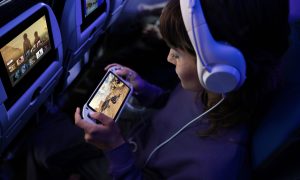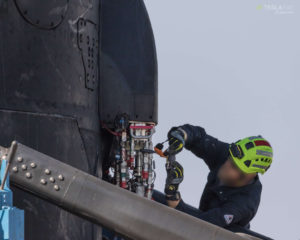

News
SpaceX Falcon 9 Block 5 rocket’s drone ship return captured in stunning detail [gallery]
Teslarati photographer Pauline Acalin has captured SpaceX’s first West Coast Falcon 9 Block 5 booster recovery in the best detail yet seen of the rocket upgrade, well-worn after its first successful launch of Iridium NEXT-7, July 25.
Iridium-7 marked a number of important debuts for SpaceX: Falcon 9 Block 5 (Booster 1048, in this case) completed its first West Coast launch from SpaceX’s Vandenberg pad, drone ship Just Read The Instructions’ (JRTI) first rocket recovery attempt and success in nearly ten months, and recovery vessel Mr Steven’s first (albeit unsuccessful) attempt at catching a Falcon fairing with a dramatically enlarged net and arms.
- B1048 returns to port on drone ship JRTI after its successful July 2019 launch debut. (Pauline Acalin)
Although inclement wind conditions foiled Mr Steven’s fairing catch effort and put pressure on Falcon 9 B1048’s journey to JRTI, Iridium-7 was flawlessly placed in orbit and Falcon 9 managed a slightly off-center but still thoroughly successful landing on the drone ship off the coast of California. With that launch and land debut on the West Coast and a second successful East Coast launch of a Block 5 rocket to the East just a few days prior, SpaceX has effectively demonstrated the basic functionality and reliability of the upgrade’s many far-reaching changes to the underlying Falcon 9 architecture.
Recovered booster 1048’s single-piece cast titanium grid fins. They were able to maneuver the vehicle through stormy winds at sea, landing it safely on Just Read the Instructions following Iridium-7 launch. #spacex #iridium7 #falcon9 pic.twitter.com/yATFVrjGjc
— Pauline Acalin (@w00ki33) July 29, 2018
Just Read The Instructions recovers a rocket
After nearly ten months largely spent berthed at SpaceX’s original Port of San Pedro dock space, drone ship JRTI has at long last returned to sea and successfully recovered a Falcon 9 booster, this time marking the West Coast launch and landing debut of the Block 5 rocket. Photos of the drone ship and rocket’s return to port were some of the best ever seen, thanks largely to the port’s layout and narrow mouth, which allowed Teslarati photographer Pauline Acalin to put giant telephoto lenses and a unique top-down perspective to good use.
Iridium NEXT-7 thankfully brought an end to the understandable but still-painful practice of intentionally expending twice-flown Falcon 9 boosters in the ocean after launch. Thanks to Iridium-7’s new Block 5 booster, B1048, expending the rocket was out of the question, as it likely will be for most Block 5 launches in the future. A combination of several expendable missions and an unfortunate duo of recovery anomalies (a small fire after Koreasat 5A and the Falcon Heavy center core landing failure) led to JRTI sitting on the sidelines since October 2017, as a considerable subset of its critical thruster hardware had to be stripped in order to keep East Coast sister ship Of Course I Still Love You (OCISLY) operational for a handful of attempts in 2018.
- Falcon 9 B1048 returns to Port of Los Angeles aboard drone ship Just Read The Instructions, July 27. (Pauline Acalin)
- Falcon 9 B1048 returned to Port of Los Angeles aboard drone ship Just Read The Instructions after its first launch. July 27. (Pauline Acalin)
- Falcon 9 B1048 returns to Port of Los Angeles aboard drone ship Just Read The Instructions, July 27. (Pauline Acalin)
- Falcon 9 B1048 returns to Port of Los Angeles aboard drone ship Just Read The Instructions, July 27. (Pauline Acalin)
- Falcon 9 B1048 returns to Port of Los Angeles aboard drone ship Just Read The Instructions, July 27. (Pauline Acalin)
Many of the months JRTI spent at berth were thus without the pod thrusters the drone ship needs to keep itself at the proper landing point once at sea. Still, JRTI departed the port with a full complement of four blue thrusters on the evening of July 22 and had a highly successful return-to-action. Sadly, it’s unclear how much SpaceX will need the vessel within just a month or two from today – after the final Iridium launch (NEXT-8) in November or December, perhaps all of SpaceX’s future Vandenberg launches will be lofting lightweight payloads that should allow the company to rely almost entirely on its brand-new rocket landing zone – conveniently colocated barely 1000 feet from the pad – for CA rocket recoveries.
F9 Block 5 shows off its upgraded exterior
Falcon 9 Block 5 booster (B1048) arrived at Port of Los Angeles on July 27 after landing at sea aboard drone ship JRTI. Photos captured by Pauline arguably show the best details yet seen of the rocket upgrade, ranging from titanium grid fins to extraordinary shots of its sooty-but-still-sorta-shiny Merlin 1D engines.
- B1048 arrives in Port of LA aboard drone ship JRTI. (Pauline Acalin)
- B1048, one launch down and dozens to come. (Pauline Acalin)
- B1048, one launch down and many more to come. (Pauline Acalin)
- B1048’s beautiful Block 5 Merlins, showing off their subtle shine despite a healthy coating of soot. (Pauline Acalin)
Myriad others provide an amazing sense of place with SpaceX technicians conducting thorough post-landing checkouts, carefully documenting the booster’s condition, and generally wrenching on a massive, orbital-class rocket that completed a suborbital jaunt to space just days prior.
Of particular note are detailed views of the silky black “highly flame-resistant felt” now covering Falcon 9’s interstage (the top segment), landing legs, octaweb section, and raceways (the black lines traveling up and down the rocket). Compared to beat-up, older Falcon 9s, B1048’s shielded components look barely worse for wear, and it would genuinely be difficult to determine if the rocket had flown before without the telltale soot fingerprint present after every Falcon 9 recovery.
- A little of everything: landing leg, octaweb, Merlin 1Ds, and drone ship JRTI. (Pauline Acalin)
- B1048’s octaweb attach points for a huge range of fluids and propellants. (Pauline Acalin)
- A SpaceX recovery technician documents one of Falcon 9 B1048’s quick-disconnect panels. (Pauline Acalin)
- One of B1048’s four upgraded landing legs. (Pauline Acalin)
- And another view of B1048’s beautifully intricate leg hardware. (Pauline Acalin)
The only mystery that still remains is what exactly Falcon 9 Block 5’s octaweb heat-shielding looks like, reportedly one of the most critical and research-intensive upgrades necessary for true rapid reusability and reliability through many, many flights. Now built largely of titanium bolted to the octaweb, among a number of other extremely heat-tolerant metals and materials and even active water-cooling in spots, the new heat-shield was designed to carry the brunt of the reentry heating Falcon 9 experiences with ease.
Perhaps we’ll get a glimpse of that yet-unseen heat-shield over the next few weeks and months. Many, many more launches to come, so stay tuned!
For prompt updates, on-the-ground perspectives, and unique glimpses of SpaceX’s rocket recovery fleet (including fairing catcher Mr Steven) check out our brand new LaunchPad and LandingZone newsletters!
Elon Musk
SpaceX Starship gets FAA nod for ninth test flight
The FAA has given the green light for Starship’s ninth test flight.

SpaceX has received FAA approval for the ninth test flight of the Starship rocket. The approval was delayed due to the federal agency finishing its comprehensive safety review of the eighth flight earlier this year.
The FAA said in a statement that it has determined that SpaceX has “satisfactorily addressed the causes of the mishap, and therefore, the Starship vehicle can return to flight.”
The eighth test flight occurred back on March 6. SpaceX completed a successful liftoff of Starship and the Super Heavy Booster, before the two entered stage separation a few minutes after launch.
Starship Flight 8: SpaceX nails Super Heavy booster catch but loses upper stage
The booster returned and was caught by the chopsticks on the launch pad, completing the second successful booster catch in the program’s history. However, SpaceX lost contact with Starship in the upper atmosphere.
The ship broke up and reentered the atmosphere over Florida and the Bahamas.
The debris situation caused the FAA to initiate a mishap investigation:
Starship Flight 8’s Ship 34 provided some beautiful fireworks in the sky during its rapid unscheduled disassembly. Beautiful but unfortunate.
Hopefully, Flight 9 would no longer have any RUD incidents. pic.twitter.com/p4qAToDXOM
— TESLARATI (@Teslarati) March 7, 2025
The FAA said it will verify that SpaceX implements all the corrective actions on Flight 9 that it discovered during the mishap investigation.
There is no current confirmed launch window, but the earliest it could take off from Starbase is Tuesday, May 27, at 6:30 p.m. local time.
To prevent any injuries and potentially limit any damage, the FAA has stayed in contact with various countries that could be impacted if another loss of vehicle occurs:
“The FAA is in close contact and collaboration with the United Kingdom, Turks & Caicos Islands, Bahamas, Mexico, and Cuba as the agency continues to monitor SpaceX’s compliance with all public safety and other regulatory requirements.”
The agency has also stated that the Aircraft Hazard Area (AHA) is approximately 1,600 nautical miles and extends eastward from the Starbase, Texas, launch site through the Straits of Florida, including the Bahamas and Turks & Caicos.
For flight 8, the AHA was just 885 nautical miles.
News
Hyundai begins real-world testing of AI-powered EV charging robot

Hyundai announced on Thursday that it has officially launched real-world testing of its AI-powered EV charging robot, which it is referring to as the ACR.
The Korean company is partnering with both Kia and Incheon International Airport for the testing phase, which was launched with a memorandum of understanding (MOU). The pilot program is going to be used to lay the groundwork for future robot use for EV charging.
Incheon already has a reputation that aligns with the pilot program as it has the largest eco-friendly vehicle infrastructure in Korea, according to Korea JoongAng Daily, which first reported the launch of the pilot program.
Hyundai is partnering with Kia’s Robotics Lab to provide hardware and software solutions for this early rollout.
Yan Hee-won, President of Hyundai Motor’s R&D Division, said:
“This marks an important turning point in validating the practical value of future mobility technologies. With customized automatic charging solutions, we aim to deliver a more convenient and enhanced mobility experience for users.”
The testing phase will be limited in the sense that the charging robot will be deployed for a fleet of eco-friendly airport vehicles. Those who park their EVs at the airport will not be able to use it for use while they’re traveling — at least at first.
Eventually, it will become a great way to give vehicles range while the owners are off on trips.
Tesla had a similar idea several years ago, which it shared viral videos of back in 2015.
Tesla “snake charger” wasn’t just a creepy one-off, suggests Elon Musk
Musk said in 2020 that Tesla still had the intention of making it. However, it has shifted to wireless induction charging, which seems to be a better option simply because of fewer moving parts and better compatibility with the upcoming Robotaxi fleet.
Tesla flexes Robotaxi wireless charging — autonomy from top to bottom
Tesla displayed its wireless charging idea at the “We, Robot” event last year:
Robotaxi wireless charging
No hands required pic.twitter.com/XL746DkGhb
— Tesla (@Tesla) October 18, 2024
Elon Musk
How Tesla could benefit from the ‘Big Beautiful Bill’ that axes EV subsidies
Tesla has a few paths to limit damage from the elimination of tax credits.

The United States House of Representatives passed President Trump’s “Big Beautiful Bill” by a vote of 215 to 214 on Thursday, effectively bringing an end to many EV subsidy programs, like the $7,500 tax credit, by the end of this year.
The bill will not only eliminate the $7,500 credit on new EV purchases, but also the $4,000 credit given on the purchase of used electric vehicles, and a $1,000 credit on the installation of Level 2 chargers. It will also impact solar subsidies that help generate clean energy in a residential setting.
EVs would also be subject to a $250 road use fee.
🚨 The “Big Beautiful Bill” has been passed in the House, meaning:
1) The EV tax credit is in serious jeopardy. It will likely be eliminated for 2026.
2) EVs will likely have a $250 road use fee
3) $1,000 Level 2 charger credit will also be eliminated pic.twitter.com/Aad41say43— TESLARATI (@Teslarati) May 22, 2025
All of these things sound like negatives — truly because they are. Those who are not in a financial position to buy an EV this year, even with the tax credit, might not be able to afford them in the coming years either, unless manufacturers are able to bring pricing to a level that is more accessible to consumers.
In theory, President Trump’s focus on bringing manufacturing back to America would bring prices down, but it won’t happen overnight. Companies will take many years to completely bring manufacturing and part sourcing to the United States.
However, Tesla could feel some positives from this bill, and it all comes down to timing. Of course, in the long term, it wouldn’t be great for the company, especially if it did not have two things going on right now: a slightly lagging delivery pace and the introduction of affordable models.
Tax Credit Sunsetting Advantage
Sunsetting the $7,500 tax credit means one thing: those who have been in limbo over buying an EV from Tesla are going to have to make a decision on whether they want to buy this year and still have access to the credit, or test their luck and hope for price reductions.
More than likely, those who have been on the fence will be willing to pull the trigger this year, and Tesla will definitely gain some sales from this fact alone. Other automakers will, too.
This could help offset Tesla’s slow start to the year, which has been caused by the changeover of production lines of the Model Y across each of its factories globally.
Affordable Models
Tesla said earlier this year that it will roll out affordable models in the first half of 2025. These cars are expected to be around the $30,000 mark, but the company has not shed any true information on what they will cost.
Potential affordable Tesla “Model 2/Model Q” test car spotted anew in Giga Texas
Ideally, the cars would cost under $30,000 without the EV tax credit, which would be more than accessible for many car buyers in the United States.
The introduction of models that are not in need of a tax credit to be affordable to the masses. This would help offset some of the losses Tesla might feel from cars losing the tax credit.
-

 News2 weeks ago
News2 weeks agoTesla Cybertruck Range Extender gets canceled
-

 News2 days ago
News2 days agoTesla posts Optimus’ most impressive video demonstration yet
-

 Elon Musk1 week ago
Elon Musk1 week agoTesla seems to have fixed one of Full Self-Driving’s most annoying features
-

 Lifestyle2 weeks ago
Lifestyle2 weeks agoAnti-Elon Musk group crushes Tesla Model 3 with Sherman tank–with unexpected results
-

 News2 weeks ago
News2 weeks agoStarlink to launch on United Airlines planes by May 15
-

 News2 weeks ago
News2 weeks agoTesla Semi gets new adoptee in latest sighting
-

 Elon Musk2 weeks ago
Elon Musk2 weeks agoBill Gates estimates DOGE cuts will cost children’s lives, Elon Musk responds
-

 News2 weeks ago
News2 weeks agoPotential affordable Tesla “Model 2/Model Q” test car spotted anew in Giga Texas



































